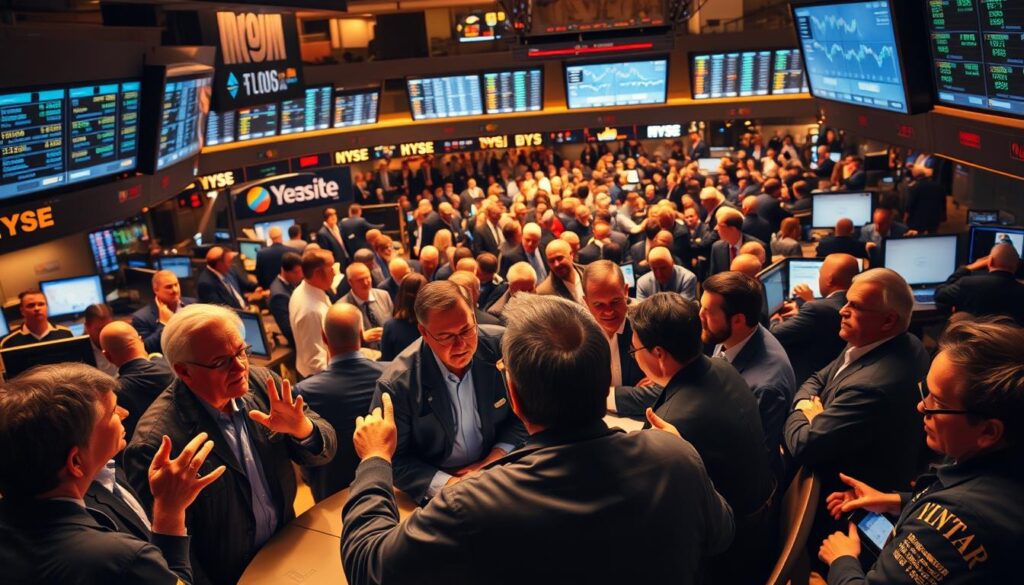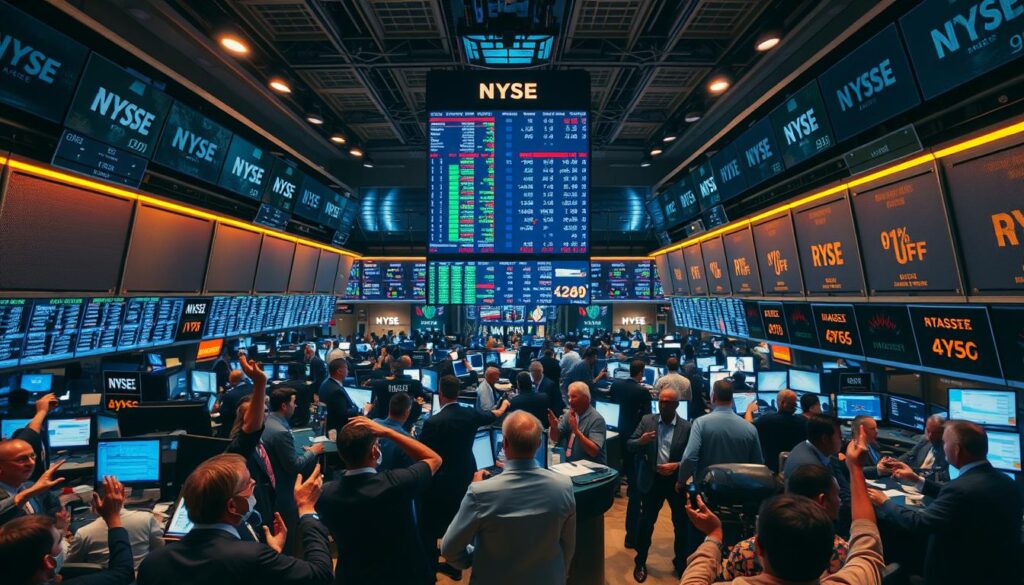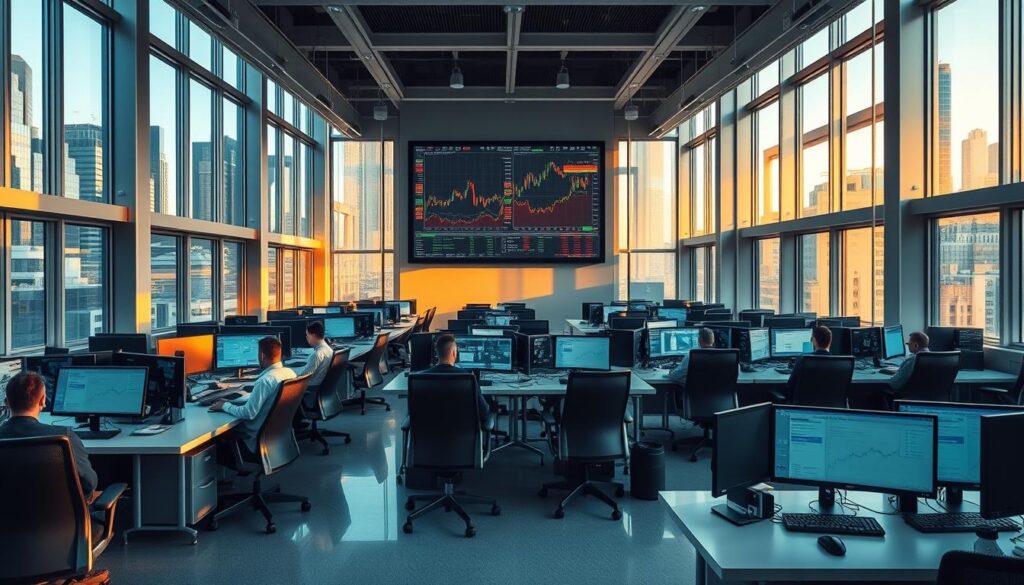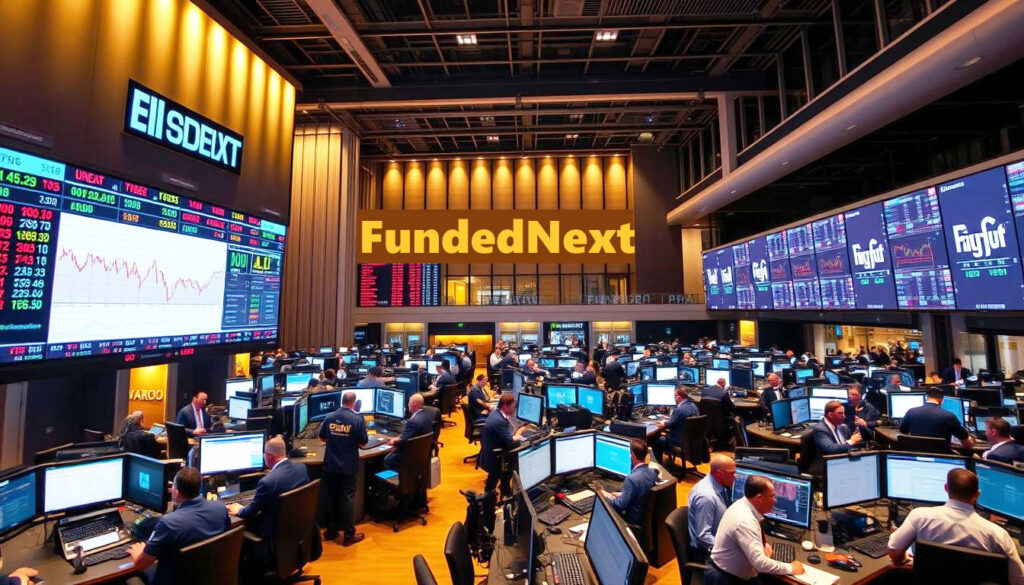Welcome to a guide exploring a modern financial powerhouse. This resource dives deep into a company founded in 2022 with a clear mission. Illimar Mattus started it to become a leader known for innovation and strong trader support.
The firm operates as a prop trading firm, providing capital to skilled individuals. Traders first pass an evaluation challenge. Successful candidates then get access to trade contracts for difference and futures.
This name carries a dual meaning. It refers to both this contemporary company and historic financial floors. Those physical pits were bustling places where deals happened face-to-face.
Readers will learn about its rapid growth and prestigious awards from organizations like Trading Live. This introduction sets the stage for understanding its unique processes and strategies.
Introduction to the Trading Pit Environment
The evolution of market execution methods showcases a remarkable journey from face-to-face interactions to electronic systems. This transformation defines how financial professionals operate in different eras.
What Defines the Trading Pit?
Historically, a trading environment centered around physical locations called pits. These were specific areas on exchange floors where open outcry occurred. Participants used vocal calls and hand signals to communicate orders.
Modern interpretations of this concept have shifted dramatically. Today’s marketplace operates through digital platforms rather than physical spaces. Electronic systems handle transactions that once required personal presence.
This digital environment combines advanced technology with real-time data feeds. Algorithmic capabilities now drive market operations. Understanding this evolution helps appreciate current opportunities available to financial professionals.
The shift from crowded floors to digital interfaces represents significant progress. Both historical and contemporary approaches share a common goal: efficient price discovery and execution.
The Origins and Evolution of Trading Pits
The journey of financial markets is a story of constant innovation, moving from chaotic floors to silent servers. This evolution fundamentally changed how deals are made. It shifted power from vocal cords to computer code.
From Open Outcry to Digital Trading
A major shift started in the 1980s. Exchanges saw that electronic systems offered faster execution and lower costs. This began the decline of the traditional open outcry method.
Phone-based orders served as a bridge between eras. They allowed for remote execution while keeping some personal contact. This transitional technology paved the way for full digital adoption.
Historical Milestones on the Trading Floor
The London Stock Exchange made a pivotal move in 1986. Its switch to electronic execution signaled a new age for European markets. Other global exchanges quickly followed this lead.
Throughout the 1990s, adoption accelerated worldwide. Italy’s Borsa Italiana (1994) and India’s Bombay Stock Exchange (1995) embraced the change. The Toronto Stock Exchange joined them in 1997.
Resistance did exist. The New York Mercantile Exchange held onto its pit until 2006. By 2016, it ceased all open outcry activity, marking a near-complete global transition.
Deep Dive into “the trading pit” Experience
Customer testimonials offer a revealing window into the real-world experience of working with a modern prop firm. These firsthand accounts provide crucial insights beyond technical specifications.
Authentic Trader Experiences
Many individuals report consistently positive encounters spanning six months to over a year. One reviewer noted their experience trading pit involved fast, friendly support teams. This reliable customer service emerges as a frequently praised aspect.
Successful payout processing represents another strength mentioned by multiple traders. Some report receiving three, four, or even eight successful withdrawals before encountering issues. This track record demonstrates the platform’s capability to deliver on financial promises.
However, not all experiences follow this positive pattern. One detailed case involved a trader with a 200K CFD Prime account. After eight successful payouts, their ninth and tenth requests were denied due to alleged over-leveraging violations.
This mixed feedback highlights important considerations for prospective traders. Key aspects of the trading pit experience include:
- Navigating evaluation challenges successfully
- Managing specific leverage and margin rules
- Understanding consistency in rule enforcement
- Building relationships with support teams
These authentic accounts provide realistic expectations for anyone considering this prop trading opportunity. They balance impressive success stories with important cautions about platform rules.
Examining Trading Platforms and Tools at TTP

The technological arsenal available to traders has evolved dramatically from basic charting tools to comprehensive analytical suites. This prop trading firm provides access to multiple professional platforms that cater to diverse strategies.
Platform Features and Technology
ATAS serves data-focused professionals who need deep market analytics. It crunches transaction data to identify emerging trends early.
Rithmic offers the fastest execution speeds for latency-sensitive strategies. Quantower provides maximum customization with open API architecture.
Supplementary tools enhance these core platforms. LiveSquawk delivers real-time market commentary. StereoTrader supports advanced functionality beyond standard interfaces.
Benefits for Modern Traders
These technological advantages translate into tangible benefits. Traders gain improved market visibility and faster execution speeds.
Reduced slippage and complex strategy implementation become possible. The combination of professional-grade platforms positions market participants for success.
Modern traders can use these tools to manage positions effectively. This represents a significant evolution from limited historical options.
Pros and Cons of Trading Pit Evaluations
Aspiring traders face a critical decision when choosing which evaluation program aligns with their goals. This prop firm’s assessment process offers distinct benefits alongside specific requirements that demand attention.
Evaluation Process Insights
The €99 starting price creates a low barrier for entry. Successful candidates receive a full refund with their first payout, making the challenge essentially free.
This account evaluation requires just three minimum trading days. Skilled individuals can demonstrate profitability quickly without extended commitments.
Participants gain free access to platforms and educational resources during the assessment phase. They also receive a certificate upon successful completion.
However, accounts face automatic closure after 20 days of inactivity. Some strategies may find the 30% margin requirement on CFD accounts restrictive.
Risk management rules include 5% maximum daily loss and 10% maximum overall loss. Profit targets vary by account type, requiring disciplined trading throughout the evaluation.
CFDs and Futures: Comparing Trading Instruments

Choosing between different financial instruments is a crucial step for any aspiring market participant. This prop firm offers two main paths: CFD accounts and futures challenges. Each has distinct characteristics that suit various styles and goals.
CFD Trading Strategies Explored
Contracts for Difference provide access to many markets. Traders can work with forex, commodities, indices, cryptocurrencies, and stocks.
Leverage varies significantly across these assets. Forex pairs offer up to 1:30, while stocks and cryptos are limited to 1:2. A CFD Prime account delivers an attractive 80% profit split for successful candidates.
It is important to note that high-frequency strategies are not permitted on these accounts. This rule shapes the type of approaches traders can implement effectively.
Futures Trading Opportunities
Futures challenges present a different structure. Capital options range from $20,000 Lite to $250,000 VIP accounts. Profit splits here vary between 60% and 80%.
These programs focus on major global indices. Unlike CFD accounts, high-frequency methods are allowed. This opens doors for scalpers and algorithmic strategies.
Understanding these differences helps individuals select the right instrument. Their choice impacts leverage, allowed strategies, and potential earnings from trades.
Overcoming Trading Challenges and Risk Management
Navigating the complex landscape of proprietary firm requirements demands careful attention to detail. Successfully completing an evaluation involves more than just generating profits. Participants must master multiple constraints simultaneously.
Understanding specific operational boundaries helps avoid common pitfalls. Each rule serves a protective purpose for both the individual and the company.
Managing Leverage and Margin Rules
The 5% maximum daily loss rule acts as a critical safety mechanism. Accounts automatically disable if equity drops below this threshold. This prevents catastrophic losses from single sessions.
Overall maximum loss is generally set at 10% of starting capital. Traders must maintain disciplined risk management to avoid approaching this boundary. Accumulated small losses can quickly become problematic.
CFD accounts enforce a 30% margin utilization limit on 1:50 leverage. Some market participants find this restriction challenging for certain strategies. Position sizing becomes crucial within these parameters.
Specific restrictions include news trading prohibitions around major announcements. Weekend holding is not permitted, eliminating gap risk. High-frequency methods are prohibited on CFD accounts but allowed on futures.
Developing a comprehensive plan accounts for all rules simultaneously. This ensures compliance while pursuing profit targets within evaluation timeframes.
Customer Testimonials and Real-World Experiences from the Pit

Authentic user experiences shed light on both the strengths and challenges of this financial platform. These firsthand accounts provide balanced perspectives for prospective candidates.
Success Stories from Traders
Many participants report positive encounters with the company. One individual received their third payout recently, calling the service “really trustworthy.”
Another market professional switched from a different prop firm by chance. They expressed satisfaction with super fast support and accurate payouts.
A reliable service experience was highlighted by a trader who received four payments. All transactions completed in less than one day from request to fulfillment.
Constructive Feedback and Cautions
Some cautionary tales reveal potential challenges. One candidate received their funded account quickly but faced issues when requesting their first payout.
Their account was breached due to alleged leverage violations. This occurred despite thirteen days of active trading without prior warnings.
Another concerning case involved eight successful payouts before denial of the ninth and tenth requests. The company cited overleveraging as the reason for account closure.
These real-world experiences emphasize the importance of understanding all rules thoroughly. Conservative leverage usage and clear communication documentation prove essential for success.
Trading Pit’s Customer Support and Technical Assistance
Effective support systems form the backbone of any successful proprietary trading operation. When technical glitches occur or account questions arise, responsive assistance becomes invaluable for market participants.
This company provides multiple communication channels for its clients. Traders can access live chat for immediate help, email support for detailed inquiries, and phone assistance for complex issues. A ticket system tracks ongoing concerns efficiently.
Customer testimonials consistently highlight the quality of this service. One reviewer noted the customer support is fast, friendly, and very helpful. Another mentioned specific staff member Mr. Alberto for his kindness and politeness during account issues.
Technical problem resolution demonstrates the firm’s reliability. One incident involved positions accidentally closing due to a system glitch. The issue was completely resolved within approximately one hour. This efficient response shows commitment to trader satisfaction.
The willingness to reactivate trades rather than just offering refunds reflects a fair approach. This customer service quality contributes significantly to positive trading experiences with the platform.
In-depth Look at Trading Pit’s Pricing and Fee Structure

Financial accessibility begins with transparent pricing models that empower market participants. This proprietary firm offers clear cost structures for various evaluation programs.
Competitive Challenge Fee Comparisons
Entry-level evaluations start at just €99. This low price point opens doors for many aspiring professionals.
CFD Classic accounts range from $10,000 to $100,000. Prime options provide better value at higher capital levels. Both one-step and two-step Prime challenges share identical pricing.
Futures evaluations offer diverse capital options. Lite accounts begin at $20,000 for €99. VIP levels reach $250,000 with corresponding fees.
Payment flexibility accommodates various preferences. Options include credit cards, digital wallets, and cryptocurrency. Binance Pay serves as the preferred method.
The refund policy makes successful challenges essentially free. Participants receive their fee back with the first payout. This transforms the cost into a refundable deposit.
Additional options include purchasing extra trading days. Reset features allow restarting from baseline capital. These provisions support diverse strategy approaches.
Innovative Features and Scaling Plans
Progressive growth opportunities represent a key innovation in modern proprietary trading frameworks. This company designed a systematic approach for financial professionals to expand their capital allocation.
Multi-Tiered Evaluation and Growth Opportunities
The scaling architecture features ten distinct progression levels. Each successful completion unlocks the next stage with increased capital.
CFD pathway participants can ultimately manage €5 million at the highest tier. Futures operators reach 100 contracts maximum allocation. This represents substantial growth from initial funded accounts.
Advancement requires maintaining 8-10% profit targets consistently. This ensures only skilled individuals progress to higher capital levels.
Unlocking Higher Profit Shares
Profit split percentages increase with each successful level completion. CFD programs offer 50-70% at lower tiers, rising to 60-80% at advanced stages.
Prime accounts provide an attractive 80% share from the beginning. Futures challenges range from 60-70% to 70-80% at VIP levels.
The company pays profit shares after each level completion. This creates regular income streams for successful participants. The structure aligns interests between the firm and its financial operators.
The Role of Open Outcry in Trading History
For centuries, the world’s major exchanges conducted business using an intricate language of shouts and signals. This face-to-face method dominated financial centers long before electronic systems emerged. Professionals gathered in designated areas called pits to execute transactions.
Market participants developed sophisticated hand signals to communicate across noisy floors. Palms facing outward indicated selling intentions, while inward-facing palms signaled buying interest. Numbers one through five used standard gestures, with six through ten shown sideways.
This system ensured complete transparency in market operations. All bids and offers occurred publicly, giving every participant equal opportunity. This approach supported efficient price discovery through open competition.
The method originated with Amsterdam’s 17th century stock exchange development. It remained the primary approach for approximately 300 years globally. These environments represented communities where relationships and reputation mattered greatly.
Understanding this historical context helps appreciate modern technological advances. Today’s electronic systems offer greater speed and accessibility compared to physical limitations of traditional methods.
Global Regulations and Accepted Countries
Corporate structures and regulatory frameworks shape how proprietary trading companies operate across borders. This prop firm maintains a sophisticated international presence through multiple entities.
The parent holding company, The Trading Pit AG, is based in Vaduz, Liechtenstein. Subsidiaries include The Trading Pit Challenge GmbH and Champions GmbH in the same jurisdiction. The Trading Pit Ltd operates from Cyprus as an EU member state.
This trading company is not regulated by financial authorities. Since it doesn’t handle client funds directly or execute trades, it falls outside brokerage definitions requiring oversight.
Services reach over 150 countries worldwide. Payment complications restrict access to Cuba, Iran, North Korea, Sudan, and Syria.
Data provider Rithmic independently blocks accounts in Myanmar, several Caribbean territories, and high-risk nations. These include Afghanistan, Libya, Palestine, Iraq, Somalia, and Zimbabwe.
CFD challenges remain unavailable to USA and Canada residents. However, futures trading options are accessible for North American participants. This reflects different regulatory considerations across instrument types.
The company maintains a Madrid office with plans for regional expansion. This global approach demonstrates commitment to serving diverse markets while respecting jurisdictional boundaries.
Enhancing Trading Techniques: Tips and Best Practices

Professional market participants consistently refine their methods to adapt to changing conditions. Effective approaches combine technical analysis with disciplined execution.
Strategy Development and Adaptation
Successful strategy creation begins with understanding specific program rules. Conservative risk management proves essential for long-term success.
Many skilled individuals risk only 0.5-1.5% per position. This approach prevents reaching daily loss limits during challenging periods.
Adaptation becomes crucial when moving through different account levels. Each stage may require adjustments to position sizing and risk parameters.
Leveraging Educational Resources
This prop firm offers comprehensive learning materials for skill development. eBooks, webinars, and blog articles provide valuable market insights.
Tools like the Economic Calendar help avoid restricted news periods. StereoTrader supports advanced algorithmic approaches for consistent execution.
The best prop traders combine technical skills with emotional control. They create sustainable approaches that generate profits while maintaining compliance.
Strategic Trading Approaches and Market Trends
Successful financial operators must master dynamic strategy adjustments in volatile conditions. This company’s rapid growth since 2022 demonstrates its position as a reliable prop partner for market professionals.
Multiple prestigious awards confirm this firm’s legitimacy. Recognition includes Most Transparent Prop Company Worldwide and Fastest Growing Prop Firm in Europe. These honors address questions about whether this platform is trading pit legit.
Adapting to Changing Market Dynamics
Strategic approaches must evolve with different market conditions. Trending periods require different tactics than range-bound consolidation. High-volatility news environments demand unique implementations.
Day trading strategies align well with this framework. Positions close before end-of-day, eliminating overnight risk. This approach capitalizes on intraday volatility while respecting platform rules.
Adaptation means recognizing when conditions favor specific strategies. Market structure analysis helps determine optimal entry and exit points. This skill proves crucial within evaluation time constraints.
The company’s Most Modern Prop Trading Technology award indicates superior infrastructure. This supports sophisticated strategy implementation across various market regimes. Long-term success requires consistent adaptation to leverage constraints and scaling structures.
Final Perspectives on Navigating Your Trading Journey
Successful participation in modern proprietary trading frameworks demands a holistic approach combining technical skill with strategic planning. This prop trading company has demonstrated reliability through thousands of successful payouts and industry recognition.
The question of whether this platform represents a trading pit legit operation finds affirmative answers. Multiple awards and transparent corporate structures confirm its standing as a best prop firm contender.
Individual experience trading varies, with most reporting positive platform reliability and responsive support. Weekly payout processing via cryptocurrency offers efficient profit distribution.
Copy trading capabilities allow strategy replication across multiple challenge accounts. However, restrictions exist to maintain fair competition and risk management protocols.
Ultimately, navigating the challenge phase requires disciplined risk management and emotional control. Success hinges on understanding specific rules while pursuing consistent profit generation.

